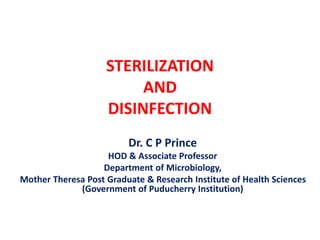
Sterilisation and Disinfection by DR C P PRINCE
- 1. STERILIZATION AND DISINFECTION Dr. C P Prince HOD & Associate Professor Department of Microbiology, Mother Theresa Post Graduate & Research Institute of Health Sciences (Government of Puducherry Institution)
- 2. TERMINOLOGY IN STERILIZATION • Sterilization – a process that destroys all viable microbes, including viruses and endospores; microbicidal • Disinfection – a process to destroy vegetative pathogens, not endospores; inanimate objects • Antiseptic – disinfectants applied directly to exposed body surfaces • Sanitization – any cleansing technique that mechanically removes microbes
- 3. TERMINOLOGY IN STERILIZATION • Degermation – mechanically removing microbes form surface (skin) such as surgical hand scrubbing, or wiping skin with alcohol prior to venipuncture • Sepsis – bacterial contamination • Asepsis – absence of significant contamination • Bactericidal (microbicidal) - -cidal means kill • Bacteriostatic (micro biostatic) - -static means inhibition of growth and multiplication
- 5. AIM OF STERILIZATION - ASEPSIS • Asepsis is the practice to reduce or eliminate contaminants (such as bacteria, viruses, fungi, and parasites) from entering the operative field in surgery or medicine to prevent infection. Ideally, a field is "sterile" — free of contaminants — a situation that is difficult to attain. However, the goal is elimination of infection, not sterility.
- 6. HOW STERILIZATION WORKS • Cell wall maintains integrity of cell . When disrupted, cannot prevent cell from bursting due to osmotic effects • Cytoplasmic membrane contains cytoplasm and controls passage of chemicals into and out of cell, When damaged, cellular contents leak out • Viral envelope responsible for attachment of virus to target cell .Damage to envelope interrupts viral replication • So…non enveloped viruses have greater tolerance of harsh conditions
- 14. Physical Methods of Microbial Control • Heat: Kills microorganisms by denaturing their enzymes and other proteins. Heat resistance varies widely among microbes. • Thermal Death Point (TDP): Lowest temperature at which all of the microbes in a liquid suspension will be killed in ten minutes. • Thermal Death Time (TDT): Minimal length of time in which all bacteria will be killed at a given temperature. • Decimal Reduction Time (DRT): Time in minutes at which 90% of bacteria at a given temperature will be killed. Used in canning industry.
- 16. BOILING • Kills vegetative cells of bacteria and fungi, protozoan trophozoites, and most viruses within 10 minutes at sea level • Temperature cannot exceed 100ºC at sea level; steam carries some heat away • Boiling time is critical • Water boils at lower temperatures at higher elevations; requires longer boiling time • Endospores, protozoan cysts, and some viruses can survive boiling
- 17. MOIST HEAT • Used to disinfect, sanitize, and sterilize • Kills by denaturing proteins and destroying cytoplasmic membranes • More effective than dry heat; water better conductor of heat than air • Methods of microbial control using moist heat • •Boiling • •Autoclaving • •Pasteurization • •Ultrahigh-Temperature Sterilization
- 18. MOIST HEAT • Pasteurization • Definition: a process in which fluids are heated at temperatures below boiling point to kill pathogenic microorganisms in the vegetative state without altering the fluid’s palatability. • Conditions: 62℃, 30min or 71.7℃, 15sec • Significance: kills vegetative pathogens • Applications: milk, beer
- 19. Pasteurisation • First used with milk: 72°C for 20 seconds • Heating to 80°C for 1 minute will kill most vegetative organisms • Examples: bed-pan washer, proctoscope
- 20. AUTOCLAVING • Pressure applied to boiling water prevents steam from escaping • Boiling temperature increases as pressure increases • Autoclave conditions – 121ºC, 15 psi, 15 minutes
- 29. PHENOL AND PHENOLICS • Intermediate- to low-level disinfectants • Denature proteins and disrupt cell membranes • Effective in presence of organic matter and remain active for prolonged time • Commonly used in health care settings, labs, and homes (Lysol, triclosan) • Have disagreeable odor and possible side effects
- 34. SURFACTANTS • Surface active” chemicals that reduce surface tension of solvents to make them more effective at dissolving solutes • Soaps and detergents • Soaps have hydrophilic and hydrophobic ends; good degerming agents but not antimicrobial • Detergents are positively charged organic surfactants • Quats – colorless, tasteless, harmless to humans, and antimicrobial; ideal for many medical and industrial application • •Low-level disinfectants
- 35. HEAVY METALS • Ions are antimicrobial because they alter the 3-D shape of proteins, inhibiting or eliminating their function • Low-level bacteriostatic and fungistatic agents • 1% silver nitrate to prevent blindness caused by N. gonorrhoeae • Thimerosal (mercury-containing compound) used to preserve vaccines • Copper controls algal growth in reservoirs, fish tanks, swimming pools, and water storage tanks; interferes with chlorophyll
- 36. ALDEHYDES • Denature proteins and inactivate nucleic acids • •Glutaraldehyde both disinfects (short exposure) and sterilizes (long exposure) • •Formalin used in embalming and disinfection of rooms and instruments
- 37. GASEOUS AGENTS • Ethylene oxide, propylene oxide, and beta- propiolactone used in closed chambers to sterilize items • Denature proteins and DNA by cross-linking functional groups • Used in hospitals and dental offices • Can be hazardous to people, often highly explosive, extremely poisonous, and are potentially carcinogenic
- 38. PROBLEMS WITH STERILITY • Lack of understanding of risk/process • physicians introducing new products (borrowed, samples) • Multidose vials • What is sterile vs not • Lack of understanding of components of process • less training
- 40. PLASMA STERILIZATION • A plasma is a quasi-neutral collection of electrons, positive ions, and neutrals capable of collective behaviour • Positive ions = free radicals • Plasma sterilization operates synergistically via three mechanisms: • Free radicals interactions • UV/VUV radioactive effects • Volatilization • Dead microorganisms = sterilization
- 41. DISADVANTAGES OF PLASMA STERILIZATION • Weak penetrating power of the plasma species. Complications arise in: • Presence of organic residue • Packaging material • Complex geometries • Bulk sterilization of many devices • Solutions: Introduce preferentially targeting UV/VUV radiation of proper wavelength
- 45. THANK YOU
